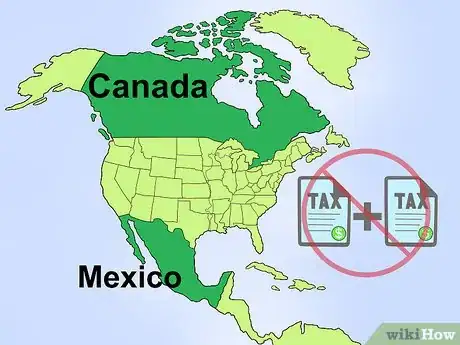This article was co-authored by Zach Pontrello. Zach Pontrello is an Embodied Leadership & Relationship Coach and the Founder of One Thought Growth & Sovereign Man Academy. His expertise lies in helping people build better relationships with themselves and with their partners, focusing on communication and honesty. Zach received his degree from John Carroll University.
There are 12 references cited in this article, which can be found at the bottom of the page.
This article has been viewed 27,757 times.
Retirement is a time of substantial change, but it should be exciting! Leaving the workforce gives you time to explore new places and pursue your interests. If you want to retire abroad, you’re not alone. There are so many attractive retirement destinations overseas that living as an expatriate in a foreign country can be an appealing option. If you’d like to pursue this path, however, it will take substantial logistical and financial planning. You’ll also need to select a country to live in, and take residency, taxation, and healthcare concerns into account. With a little bit of research and planning, there’s no reason you can’t find the right balance between affordable and best amenities for you.
Steps
Accounting for Finances and Health Care
-
1Calculate how much savings and income you’ll have. Prior to any substantial planning for moving abroad, you’ll need to calculate finances. An easy way to do this is to break down projected monthly income: how much you’ll receive from a retirement annuity, plus any income you have from pensions, Social Security, and investments.[1] Keep in mind that, if you’re concerned that you won’t have enough income to live comfortably abroad, you could pick up a part-time job in the country you retire to.
- You should also look into local exchange rates in countries you’re considering moving to; you may be surprised (whether pleasantly or unpleasantly) at the value your native currency gains or loses.
-
2Don’t count on receiving Medicare abroad. If you’re an American senior over 65 years of age, you’re eligible to receive Medicare in the United States. However, Medicare benefits do not apply overseas, so you’ll be cut off from this resource if you retire abroad.[2] Seniors who are considering retiring abroad initially before returning to the United States for their final years will be able to receive Medicare, but will have a premium 10% higher for every 12-month period they were not enrolled.[3]
- Unlike Medicare, other senior financial programs do not require you to live in the United States. For example, Social Security will continue to pay a retirement annuity if you retire abroad. Confirm this by contacting the Social Security Office of Earnings and International Operations.[4]
Advertisement -
3Research local medical care and costs. Seniors often need to receive extensive health care after retirement, and without the benefit of Medicare, have three primary options. Seniors can purchase an international health insurance policy, purchase a health insurance policy in the country they retire to, or pay for all health-care expenses out of pocket.[5]
- Paying out of pocket is not necessarily a bad option; many foreign countries have relatively inexpensive health care (Especially in comparison to the U.S.) and so you may be able to save money by not purchasing health insurance.
- Finally, in nations with socialized health care, you won’t need to worry about health insurance at all.
Planning Ahead for Residency and Taxation
-
1Look into establishing residency. If you’ll be living as an expatriate permanently, you’ll need to establish residency within the country you move to. This can be a complicated process, and it’s a factor that can strongly influence your choice of retirement destination. Most countries welcome foreign retirees, and some only require that you own property to qualify for residency. Many other nations require you to earn a specific amount of monthly income to become a resident.[6]
- For example, Panama’s pensionado plan requires retired seniors to have a monthly income of $1,000 (including Social Security) in order to qualify for residency. On a similar type of plan, Ecuador requires an income of $800 a month, and Nicaragua and Columbia each require over $600 a month.[7]
- Certain countries—including Ecuador, Panama, and the Dominican Republic—offer residency to immigrants who are willing to make a financial investment in the nation.[8]
-
2Consider part-time residency. If the country you plan to retire to has a prohibitive residency policy—for example, they require residents to earn a monthly income that you can’t achieve—you can skirt this issue by only retiring part-time. This means that you would live abroad for a portion of the year (say, 6 months) and live in your native country for the remainder of the year.[9]
- This allows you to maintain residency in your native country while still being able to spend substantial time retired abroad.
-
3Apply for a permanent residence visa. In some cases, a foreign government will require non-native residents—including senior-age retirees—to obtain a residence visa. This document functions similarly to other types of visa and gives you legal permission to reside in a country that you have emigrated to. Residence visas are often initially given for a brief period of time (e.g. two years) which can later be extended as needed.[10]
- Be sure to check with the State Department of nations that you’re considering retiring to and ask about their residence visa policies. Some countries may have more stringent requirements than others.
- Some nations that do not require visitors to hold a visa will require one of even temporary residents.
-
4Avoid double taxation abroad. Regardless of where you retire to abroad, you’ll still need to pay income tax to the American government. American retirees looking for lower taxation abroad are often disappointed when they find that their new residency status does not result in a lowering of taxes. In order to avoid being taxed by the American government and a foreign government (i.e. double taxation), consider moving to a country such as Mexico or Canada that has a standing tax treaty with the U.S. to prohibit double taxation.[11]
- Even if you plan to relinquish your American citizenship—an uncommon move—or move your financial assets to a foreign country, the U.S. government has laws in place which force you to continue paying income tax.
- Retirees from other countries will likely still be taxed by their respective native governments and would need to contact their nation’s State Department for further information.
Deciding on a Location and Lifestyle
-
1Talk the decision through with your family. On a personal level, you may want to seek out the opinion and approval of your family before making the decision to move abroad, especially if you have siblings or children you’d like to stay in touch with. Retiring abroad can be an isolating experience for you (and your partner, if you’re not retiring alone), and it’s important to have the support of family members and close friends during this transition.[12]
- Also bear in mind that moving from a familiar culture to a foreign one can be a challenging experience, especially if you haven’t traveled abroad much before. Prepare yourself for this culture shock by making smaller trips in advance of your retirement, and reading as much as possible about the culture you’ll be retiring into.
-
2Look for a country with weather that you enjoy. Many retirees want to live comfortably after they retire, and value mild, warm weather as part of that comfortable living. To this end, many expatriate retirees relocate to the Caribbean, which has warm summers, mild winters, and miles of sandy coast. For North American expatriates looking to live further abroad, Chiang Mai, Thailand offers a pleasant climate and low healthcare expenses.[13]
- Parts of Western Europe are also becoming increasingly affordable for expatriate retirees, including Valencia, Spain, where residents can find a decently sized apartment for around $400 a month.
- Many South American options have mild weather and cultures friendly to foreign retirees, including Buenos Aires, Argentina, and the country of Guatemala.[14]
-
3Compare the costs of living in countries you’re considering retiring to. This is another major decision which can strongly influence expatriate retirees’ location. If you choose to retire to a nation with lower cost of living and a financial exchange rate that will benefit your native currency, you can live comfortably on substantially less money than you might need in your native country. For example, Mexico has an exchange rate that favors the dollar. Panama also has a low cost of living, especially for American expatriates as do South American countries like Belize and Peru.[15]
- Keep in mind that, even if the cost of living in a foreign country is lower than it would be at home, you’ll still be faced with the cost of relocation, plus amenities such as electricity, cell phone bills, and transportation. These factors could cost more abroad.[16]
-
4Visit the country before you move there. This is especially important if you’ve never before visited a country you’re planning to retire to, or have visited only briefly. Retirees often live two or three decades after they retire, so you’ll be spending many years in whichever country you choose. To make sure that you’ll enjoy your retirement, take a lengthy trip—at least a month—to the country and investigate living in local communities.[17]
- If you’re planning well in advance, you could even rent a small house or apartment in the country, and give yourself a 6-month trial run. If you still enjoy the country after that time, then continue with the plan to retire abroad.
References
- ↑ http://money.usnews.com/money/blogs/on-retirement/2015/06/16/how-to-retire-overseas-in-7-steps
- ↑ https://travel.state.gov/content/passports/en/abroad/events-and-records/retirement-abroad.html
- ↑ https://www.ml.com/articles/retiring-abroad-heres-what-you-need-to-know.html
- ↑ https://www.ssa.gov/foreign/
- ↑ http://money.usnews.com/money/blogs/on-retirement/2015/06/16/how-to-retire-overseas-in-7-steps
- ↑ http://www.kiplinger.com/article/retirement/T037-C000-S002-how-to-retire-abroad.html
- ↑ http://www.liveandinvestoverseas.com/how-to/best-options-to-establish-residency-in-another-country.html
- ↑ http://www.liveandinvestoverseas.com/how-to/best-options-to-establish-residency-in-another-country.html
- ↑ http://www.kiplinger.com/article/retirement/T037-C000-S002-how-to-retire-abroad.html
- ↑ https://www.study-in.de/en/plan-your-studies/requirements/visa-and-residence-permit_26604.php
- ↑ https://www.ml.com/articles/retiring-abroad-heres-what-you-need-to-know.html
- ↑ https://www.ml.com/articles/retiring-abroad-heres-what-you-need-to-know.html
- ↑ http://www.bankrate.com/finance/retirement/cheap-places-to-retire-abroad-2.aspx
- ↑ http://www.bankrate.com/finance/retirement/cheap-places-to-retire-abroad-5.aspx
- ↑ http://www.forbes.com/sites/lawrencelight/2016/12/10/how-to-retire-abroad-and-where-to-go/
- ↑ https://www.ml.com/articles/retiring-abroad-heres-what-you-need-to-know.html
- ↑ http://www.huffingtonpost.com/kathleen-peddicord/retiring-abroad_b_6063946.html







































































